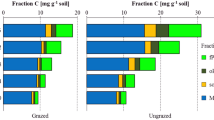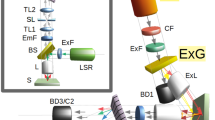Abstract
The ideal tool for the analysis of soil organic matter would enable structural group analysis to be performed on whole soil samples in a non-destructive manner. However, up till now, there have been no adequate techniques available to characterize the structure of amorphous humic compounds in the solid state. Moreover, it has not been possible to dissolve all the organic material from the soil and obtain soluble material for analysis without chemical alteration during solvent extraction or pyrolysis. Although conventional NMR spectra of amorphous solids reveal no structural information due to large dipolar interactions, the use of high power cross-polarization (CP) techniques1 has overcome difficulties in obtaining 13C NMR spectra of solids to the extent that spectra can be obtained in much shorter times and organic functional groups partly resolved. We now report the first recorded 13C NMR spectra of whole soils and show that this technique has the potential for structural analysis of organic matter in solid soil samples.
This is a preview of subscription content, access via your institution
Access options
Subscribe to this journal
Receive 51 print issues and online access
$199.00 per year
only $3.90 per issue
Buy this article
- Purchase on Springer Link
- Instant access to full article PDF
Prices may be subject to local taxes which are calculated during checkout
Similar content being viewed by others
References
Pines, A., Gibby, M. G. & Waugh, J. S. Phys. Lett. 15, 373–376 (1972); J. chem. Phys. 59, 569–590 (1973).
Mehring, M. High Resolution NMR Spectroscopy in Solids (Springer, Berlin, 1976).
Vanderhart, D. L. & Retcofsky, H. L. Fuel 55, 202–204 (1976).
Bartuska, V. J., Marciel, G. E., Schaefer, J. & Stejskal, E. O. Fuel 56, 345–358 (1977).
Molloy, L. F. & Blakemore, L. C. N.Z.J. Sci. 17, 233–255 (1974).
Campbell, A. S., Young, A., Livingstone, L., Wilson, M. A. & Walker, T. W. Soil Sci. 123, 362–366 (1977).
New Zealand Soil Bureau, N.Z. Soil Bur. Bull. 26, 1–27 (1968).
Wilson, M. A., Jones, A. J. & Williamson, B. Nature 276, 487–489 (1978).
Wilson, M. A. & Goh, K. M. J. Soil Sci. 28, 645–652 (1977).
Ogner, G. Soil Biol. Biochem. 11, 1058 (1979).
Ludemann, H. D., Lentz, H. & Vila, J. F. Biochem. Biophys. Res. Commun. 72, 1063–1070 (1976).
Newman, R. H., Tate, K. R., Barron, P. F. & Wilson, M. A. J. Soil Sci. (in the press).
Kononova, M. M. Soil Organic Matter 2nd edn, 73–78 (Pergamon, Oxford, 1966).
Schnitzer, M. & Khan, S. U. Soil Organic Matter (Elsevier, New York, 1978).
Grant, D. Nature 270, 709–710 (1977).
Anderson, H. A. & Russell, J. D. Nature 260, 597 (1976).
Author information
Authors and Affiliations
Rights and permissions
About this article
Cite this article
Barron, P., Wilson, M., Stephens, J. et al. Cross-polarization 13C NMR spectroscopy of whole soils. Nature 286, 585–587 (1980). https://doi.org/10.1038/286585a0
Received:
Accepted:
Issue Date:
DOI: https://doi.org/10.1038/286585a0
This article is cited by
-
Aspects of the chemical structure of soil organic materials as revealed by solid-state13C NMR spectroscopy
Biogeochemistry (1992)
-
Cross-polarization 13C-NMR spectroscopy with ‘magic angle’ spinning characterizes organic matter in whole soils
Nature (1981)
-
Humic soil and coal structure study with magic-angle spinning 13C CP-NMR
Nature (1981)
Comments
By submitting a comment you agree to abide by our Terms and Community Guidelines. If you find something abusive or that does not comply with our terms or guidelines please flag it as inappropriate.



